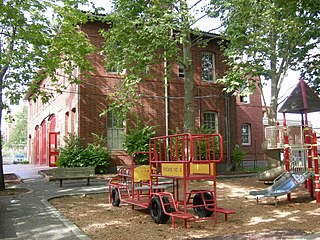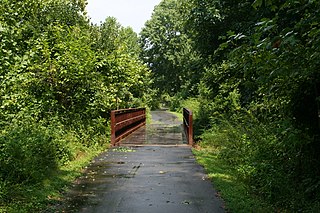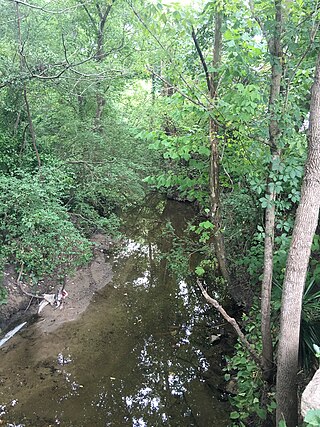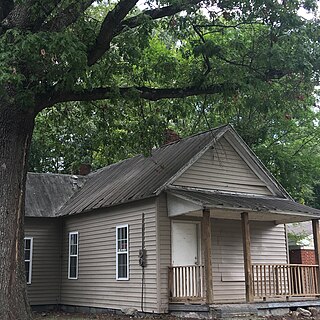
Durham is a city in the U.S. state of North Carolina and the county seat of Durham County. Small portions of the city limits extend into Orange County and Wake County. With a population of 283,506 in the 2020 census, Durham is the 4th-most populous city in North Carolina, and the 71st-most populous city in the United States. The city is located in the east-central part of the Piedmont region along the Eno River. Durham is the core of the four-county Durham-Chapel Hill, NC Metropolitan Statistical Area, which had a population of 649,903 at the 2020 census. The Office of Management and Budget also includes Durham as a part of the Raleigh-Durham-Cary, NC Combined Statistical Area, commonly known as the Research Triangle, which had a population of 2,043,867 at the 2020 census.

Soul City is a community in Warren County, North Carolina, United States. It was a planned community first proposed in 1969 by Floyd McKissick, a civil rights leader and director of the Congress of Racial Equality. Funded by the United States Department of Housing and Urban Development, Soul City was one of thirteen model city projects under the Urban Growth and New Community Development Act. It was located on 5,000 acres (20 km2) in Warren County near Manson-Axtell Road and Soul City Boulevard in Norlina.

Burleith is a neighborhood in Washington, D.C., United States. It is bordered by 35th Street NW to the east, Reservoir Road NW and the historic Georgetown district to the south, Whitehaven Park to the north, and Glover Archbold Park to the west. The neighborhood is home to the Duke Ellington School of the Arts and the Washington International School.

The Central Area, commonly called the Central District or The CD, is a mostly residential district in Seattle located east of downtown and First Hill ; west of Madrona, Leschi and Mt. Baker; south of Capitol Hill, and north of Rainier Valley. Historically, the Central District has been one of Seattle's most racially and ethnically diverse neighborhoods, and was once the center of Seattle's black community and a major hub of African-American businesses.

Ellerbe Creek is a tributary of the Neuse River in North Carolina, USA. It is part of the Neuse River Basin, and flows for more than twenty miles through North Durham. The Ellerbe's watershed begins near Orange County north of Interstate 85, near the WDNC radio tower and Bennett Place. The creek flows through many of Durham's most historic and culturally significant areas, including Ninth Street, Downtown Durham, beneath Durham Athletic Park, The North Carolina School of Science and Mathematics, the Museum of Life and Science, the old Durham Landfill, Duke University East Campus, Trinity Park, Walltown, Northgate Mall, and towards the end crosses Fishdam Road. The Ellerbe eventually flows into Falls Lake, about a mile south of the Eno River.

Dye Branch is a small creek that runs from Duke University's East Campus, through the Trinity Heights, Walltown, and Old West Durham neighborhoods of Durham, North Carolina. From its headwaters near the Food Lion grocery store on Hillsborough Road, Dye Branch flows for three miles (5 km) through some of Durham's oldest and most densely developed neighborhoods: Old West Durham, Walltown, Northgate Park, and Trinity Park. South Ellerbe joins Ellerbe Creek in a small forest—just northwest of the I-85/Roxboro Road interchange. Along some wooded stretches, the creek quietly flows over rocks and is as scenic as any in western North Carolina. In other areas, South Ellerbe is a troubled creek. Its history is marred by rampant pollution and devastating abuse. Though community organizations have arisen to advocate on behalf of the small drainage in recent years, future developments pose significant challenges.

Floyd Bixler McKissick was an American lawyer and civil rights activist. He became the first African-American student at the University of North Carolina School of Law. In 1966 he became leader of CORE, the Congress of Racial Equality, taking over from James Farmer. A supporter of Black Power, he turned CORE into a more radical movement. In 1968, McKissick left CORE to found Soul City in Warren County, North Carolina. He was an active Republican and endorsed Richard Nixon for president that year, and the federal government, under President Nixon, supported Soul City. He became a state district court judge in 1990 and died on April 28, 1991. He was a member of Alpha Phi Alpha fraternity.

Watts Hospital, located in Durham, North Carolina was the city's first hospital, operating between 1895 and 1976.
Douglas E. Moore was a Methodist minister who organized the 1957 Royal Ice Cream Sit-in in Durham, North Carolina. Moore entered the ministry at a young age. After finding himself dissatisfied with what he perceived as a lack of action among his divinity peers, he decided to take a more activist course. Shortly after becoming a pastor in Durham, Moore decided to challenge the city's power structure via the Royal Ice Cream Sit-in, a protest in which he and several others sat down in the white section of an ice cream parlor and asked to be served. The sit-in failed to challenge segregation in the short run, and Moore's actions provoked a myriad of negative reactions from many white and African-American leaders, who considered his efforts far too radical. Nevertheless, Moore continued to press forward with his agenda of activism.
John Sprunt Hill was a North Carolina lawyer, banker and philanthropist who played a fundamental role in the civic and social development of Durham, North Carolina, the expansion of the University of North Carolina at Chapel Hill and the development of rural credit unions in North Carolina during the first half of the 20th century.

Hayti, also called Hayti District, is the historic African-American community that is now part of the city of Durham, North Carolina. It was founded as an independent black community shortly after the American Civil War on the southern edge of Durham by freedmen coming to work in tobacco warehouses and related jobs in the city. By the early decades of the 20th century, African Americans owned and operated more than 200 businesses, which were located along Fayetteville, Pettigrew, and Pine Streets, the boundaries of Hayti.

Mary Duke Biddle Trent Semans was an American heiress, activist, politician, and philanthropist. She was the granddaughter of Benjamin N. Duke and the great-granddaughter of Washington Duke, both tobacco and energy tycoons who helped start Duke University. Semans is remembered for her support and work towards promoting the arts and humanities through various philanthropic entities.

Nello L. Teer Company was a privately owned General Contracting firm founded in 1909 by Nello Leguy Teer. The Nello L. Teer Company was headquartered in Durham, North Carolina and grew to be one of the largest construction companies in the world. Koppers of Pittsburgh, Pennsylvania purchased the Nello L. Teer Company and today much of the aggregate assets are part of Lehigh Hanson - HeidelbergCement in North America, rail assets are part of CSX, the road construction aspects are held within the Colas Group, and some of the real estate management aspects were transferred to Teer Associates.
The Royal Ice Cream sit-in was a nonviolent protest in Durham, North Carolina, that led to a court case on the legality of segregated facilities. The demonstration took place on June 23, 1957 when a group of African American protesters, led by Reverend Douglas E. Moore, entered the Royal Ice Cream Parlor and sat in the section reserved for white patrons. When asked to move, the protesters refused and were arrested for trespassing. The case was appealed unsuccessfully to the County and State Superior Courts.

Lincoln Hospital was a medical facility located in Durham, North Carolina founded to serve the African Americans of Durham County and surrounding areas. With original hospital construction financed by the Duke family, Lincoln served as the primary African American hospital in Durham from its opening in 1901 until 1976, when it closed and transferred its inpatient services to Durham County General Hospital.
The following is a timeline of the history of the city of Durham, North Carolina, USA.
Measurement Incorporated is an educational testing company based in Durham, North Carolina. The company was founded in 1980 by Dr. Henry Scherich. Measurement Incorporated currently administers state-wide standardized tests for Arizona, California, Michigan, and Washington State. Measurement Incorporated also administers the Independent School Entrance Examination (ISEE) for the Educational Records Bureau.

East Campus is part of Duke University's campus in Durham, North Carolina. East Campus, along with West Campus, make up most of Duke's main campus. The campus follows the Georgian architecture style, making it distinct from West Campus. Currently, East Campus is the exclusive residential home to first-year students. It borders Trinity Historic District to the east and Walltown Neighborhood to the north.

The George Wall House, also called Old Man Wall's House, is a historic shotgun house in the Walltown Neighborhood in Durham, North Carolina.

Immaculate Conception Catholic Church & Immaculata Catholic School are a Catholic parish church and parochial school run by the Order of Friars Minor in downtown Durham, North Carolina. The church and school are located in the Burch Avenue Historic District. Immaculate Conception is the oldest Catholic congregation in Durham, and the affiliated school was the city's first Catholic school.





















